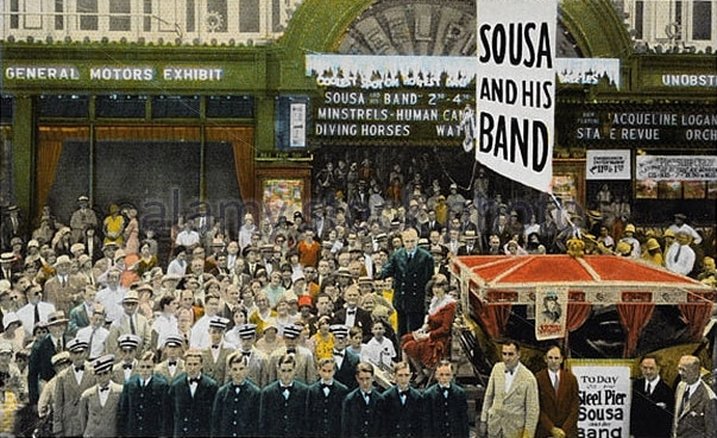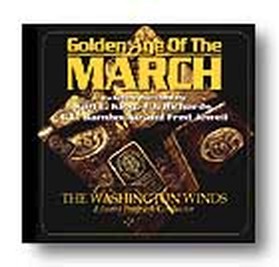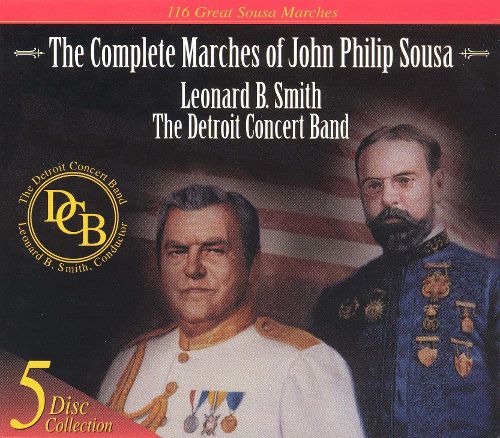John Philip Sousa
For an in-depth read about Sousa as well as my personal involvement with his music, click the following link:
www.paulsonmusic.com/Sousa.html
For an in-depth read about Sousa as well as my personal involvement with his music, click the following link:
www.paulsonmusic.com/Sousa.html
Sousa March Music - FREE DOWNLOAD
The USMC official website has an incredible website dedicated to the music of Sousa.
1) you can download free Sousa marches;
2) you can read history and performance notes of each march;
3) you can read AND print all the scores along with all the individual parts.
(click the following link - or the word 'website')
http://www.marineband.marines.mil/Audio-Resources/The-Complete-Marches-of-John-Philip-Sousa/
1) you can download free Sousa marches;
2) you can read history and performance notes of each march;
3) you can read AND print all the scores along with all the individual parts.
(click the following link - or the word 'website')
http://www.marineband.marines.mil/Audio-Resources/The-Complete-Marches-of-John-Philip-Sousa/
Sousa in Atlantic City, N.J. (circa 1930)
OR...
Purchase the complete set of all marches now, if you desire...
(if you can't wait for the USMC to complete more volumes,
then here are two sites I recommend for online purchase.
Purchase the complete set of all marches now, if you desire...
(if you can't wait for the USMC to complete more volumes,
then here are two sites I recommend for online purchase.
1. "The Golden Age of the March"
(4 CD set - these also include other marches from Henry Filmore, etc.)
(4 CD set - these also include other marches from Henry Filmore, etc.)
2. "The Complete Marches of John Philip Sousa"
(If you want to purchase ALL his marches, I recommend this set...
...they are second in performance quality to the USMC band)
(If you want to purchase ALL his marches, I recommend this set...
...they are second in performance quality to the USMC band)
More 'Stuff' on John Philip Sousa
This is a short 'history' of Sousa - created by a young girl student.
Some of the 'cleanest' and most exciting and stirring music you will ever hear comes from John Philip Sousa marches.
- The rhythms from the percussion section are right 'on' the down-beat and fire up a person's inner spirit without any negative influence on the 'flesh';
- The harmonies have no dissonance;
- There are often two or three counter-melodies going on from within the march, none of which conflict or battle with any other melody - and the melodies are such that few listeners will ever forget!
Sousa is the person who coined the phrase, "canned music" and said that along with the invention of the phonograph, music will destroy America. How right he was.
I say that Sousa music was written and performed at the peak of America's greatness; every time I hear a Sousa march, I get stirred. When I hear 'The Stars and Stripes Forever' and see the American flags, I get tears in my eyes every time.
My own personal closest association to Sousa and his music have been:
In the late 1800's and early 1900's, every house had a piano and almost every club or organization had its own band, like businesses have softball teams today. If they wanted to hear music in those days, they either had to play it themselves or hire out. Today, we can barely keep a band in a school program let alone get an audience of parents to be interested in their kids enough to listen. Few people can play anything but a CD or Ipod, etc. and have no clue as to the language of music, which would also include music history and theory - with some added performance skills!
I say that Sousa music was written and performed at the peak of America's greatness; every time I hear a Sousa march, I get stirred. When I hear 'The Stars and Stripes Forever' and see the American flags, I get tears in my eyes every time.
My own personal closest association to Sousa and his music have been:
- 1) my school band director was the son of a Sousa band member; we played many of Sousa's marches as we marched in HS parades, etc.
- 2) Dr. Leonard B Smith, conductor of the Sousa March Set of CD's, was my director for SD Allstate band in 1968.
- 3) I have always tried to teach about and / or direct a Sousa march in all of the schools I have taught. They are often just technically too difficult for the average student these days, but there are those few rare musicians who can still accept that challenge.
- 4) I continue to play along with Sousa recordings on my trumpet and low brass instruments. Those must have been some great days in America!
- 5) I have read Sousa's autobiography as well as watched many times the video of Sousa's life put out by PBS - as well as the History of Band's In America," also put out by PBS, and are both worthy of your own purchase and study.
In the late 1800's and early 1900's, every house had a piano and almost every club or organization had its own band, like businesses have softball teams today. If they wanted to hear music in those days, they either had to play it themselves or hire out. Today, we can barely keep a band in a school program let alone get an audience of parents to be interested in their kids enough to listen. Few people can play anything but a CD or Ipod, etc. and have no clue as to the language of music, which would also include music history and theory - with some added performance skills!
A Few Comments About a March to Help You Listen Closer:
- Marches are structured to exactness!
- The themes of each section is 'almost always' in groups of 4,8,16 or 32 measures.
- The melodies are some of most spirited and exciting melodies you will ever hear.
- Listen closely, and you will hear countermelodies that do not compete, they only add to the music.
- Listen to the various instruments:
- the Woodwinds are doing scales and arpeggios up and down so quickly and smoothly. Only a clarinets or flautist would appreciated the difficulty.
- The high brass are as brilliant and bright as can be!
- The low brass not only supports the foundation of the entire march, the 'upper' low brass often have countermelodies worth listening to!
- There is a lot of sudden dynamic (loud-soft) changes. Often the brass quiets down and the woodwinds are featured.
- Following the introductory sections, there is a 'dogfight' in the middle. It is when the brass and woodwinds fight each other, then moving into what is called the 'trio.' The first time through the trio, the brass allows the woodwinds to show off their melody. But on the second time, the brass take over!
- The 'beat' in a march is a 'clean' beat - meaning it is a sympathetic beat to our own heart beat. There is no 'off-beat' or what is called 'syncopation' that conflicts with own bodily beat of the heart and blood flowing through our bodies. It tends to perk us up, but never goes against us! That is also why a good march is actually healthy to listen to!
- Any dissonance found in a march is quickly resolved. Never is the listener left in the frustrated, stressed or neurotic mode as so much of today's popular music leaves everyone these days.


